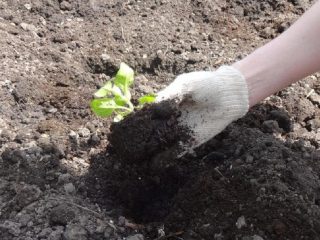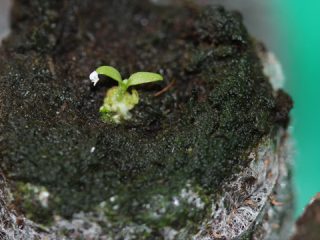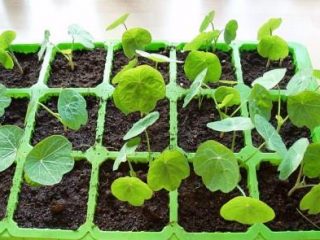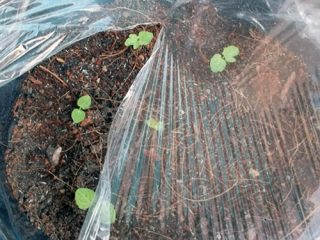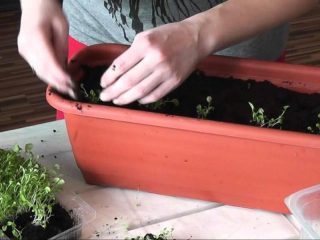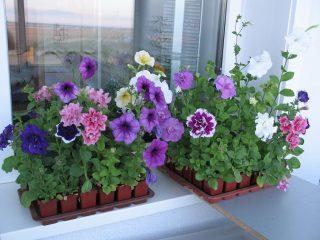Content
Foxglove is a well-known garden crop in Russia, which is grown everywhere on land of any composition and purpose. The plant surprises with its large, numerous buds, which have different colors, depending on the variety. Growing foxglove seedlings from seeds is carried out using proven technology. The owner just needs to follow the instructions.
What does foxglove seedling look like?
Before analyzing the growing process, you should take a closer look at the crop. Foxglove is classified as a herbaceous plant, closely related to plantain. It can be a biennial or a perennial - the determining factor here is the species.

During cultivation, foxglove seedlings can produce more than 1.5 million seeds
Foxglove seedlings, as seen in the photo, have the appearance of small seedlings with characteristic erect stems. Over time, they branch, forming a large number of leaves.The leaf blades are also different - from oblong xiphoid to round ovoid shapes.
Flowering is long-lasting, occurring from early summer to early autumn. During this period, the foxglove forms buds. They resemble miniature bells. However, in some varieties the flowers are not so small. As they bloom, the bells acquire a purple, red, pink or yellow hue.
As is typical for all plants, foxglove produces fruits—in its case, capsules. Thousands of small seeds are hidden under their body. Only a few will be sold under natural conditions, since many will not find the conditions necessary for cultivation. The seeds are a symmetrical tetrahedron or cylinder with a small depression on one side. The shell often contains small cells.
When to sow foxglove for seedlings
Seeds are planted in mid-spring if the growing region is cold enough. In warm climates, the procedure is performed earlier, around the end of February or early March. But transplanting into open ground is no longer carried out in June, but closer to May.
In Siberia, the warm season comes late, so it is advisable to postpone work until the last week of March. They begin to transplant seedlings no earlier than the summer month.
How to grow foxgloves from seeds
The planting process is simple - the main thing is to create the conditions necessary for seedlings. Foxglove needs specific soil, container depth, lighting and temperature. Each factor should be analyzed separately.
Soil preparation
Growing perennial foxglove from seeds should take place in a nutritious substrate. There is no big difference in where the land was taken. The owner can prepare it by mixing garden soil with humus and peat and adding a share of river sand, or purchase soil in a store.

As a rule, store-bought soil is already sterilized, but to grow foxglove seedlings it is better not to risk it and treat it
In any case, it needs to be disinfected: poured with the fungicide Fitosporin or hardened in the oven. For prevention they do both.
Selection of capacity
The foxglove seedlings will spend the first time in a container. Its optimal size is 12-15 cm. Holes are made in the bottom of the pot or container to drain excess water. After this, the container, like soil, is disinfected by calcination and treatment.
Seed selection and preparation
To make cultivation quick and effective, the seeds are carefully prepared. To do this, dilute water with potassium permanganate in a small concentration, immerse the seeds in the solution, wait for 25 minutes and remove.
After washing, the treatment is repeated, but in a new solution: a few drops of Zircon are added to 100 ml of water. The seeds are kept in the resulting liquid for three hours.

If Zircon is not at home or in the store, use Epin - it is prepared according to the same scheme
Some people use boiling water, soaking future seedlings for six days. But it takes longer, and the owner needs to change the fluid four times a day. On the other hand, if deadlines are not rushed, this method is reliable and justified.
Scheme for sowing foxgloves for seedlings
Time to start the main thing - growing seedlings.There is nothing technically difficult about this if you stick to the order. To plant foxgloves, you need a treated container with soil (also treated). But the soil has not yet been laid, but drainage material has been poured: coarse sand, pebbles or something else.
Then fill the remaining space with soil. Leave 2-3 cm of free space on top. It is not necessary to dig grooves for seedlings - you can press them down with your finger. But watering is extremely necessary.

After the seeds are scattered, the ground is moistened, and a thin layer of sand is poured on top, which is also moistened
To grow foxglove seedlings, you need a constant positive temperature. In Russia there are problems with this, so the container must be covered with film. The container is placed on the windowsill and kept until shoots appear. Direct light is best avoided as it harms young shoots.
Further care of seedlings
After planting foxglove seeds, it requires care. It consists in:
- hydration;
- applying fertilizers;
- choice of lighting and temperature.
The importance of regular fungicidal treatments should not be excluded.
While the foxglove seedlings are under the film, you need to monitor the humidity. The droplets formed as a result of condensation are removed. And at least once a day the container is ventilated.
Temperature
Growing foxgloves in greenhouse conditions (under film) involves almost no risk. But as soon as it becomes necessary to remove the cover, new problems befall the owner. First of all, they are related to temperature. Now seedlings need a less hot environment - about +20 °C. If the temperature is higher than recommended, growth will slow down.In this case, the foxglove is transferred to the cellar or outside under a canopy.
Lighting
In the early stages of cultivation, when the seedlings are under the film, abundant lighting is avoided. After the shoots emerge, they are guided by the opposite - place the container on the windowsill without closing the window.

Foxglove seedling leaves are UV resistant, making them easy to grow
Watering and fertilizing
Moistening of seedlings should be regular. Luckily, foxgloves survive short periods of heat just fine, so you don't have to worry about drying out. But as soon as the soil begins to dry out, but has not yet formed a crust, it is sprayed with a sprayer.
During further cultivation, when the foxglove is outside, it is watered only on dry days. The rest of the time, the plant needs enough precipitation and groundwater. Regardless of the location, in a container or in open ground, the soil is loosened after watering. This is done to improve permeability and aeration. In addition, the soil must be systematically weeded.
As for fertilizers, the crop is similar to other garden plants. Nitrogen and other mineral elements are used to stimulate growth. They are introduced in the spring, and in the summer they switch to organic additives: wood ash, cow manure, bird droppings. By the time autumn arrives, preparations containing potassium and phosphorus are used.
Picking
Growing foxgloves in a cramped container is not always beneficial. Of course, the owner will be able to obtain many viable specimens, but most of them will be small and thin. Therefore, when three leaves open on the sprouts, they are transplanted into a larger container - an individual glass, pot or box.

Many people initially plant foxgloves separately or in small seedlings; with this cultivation, picking will not be necessary
When picking, the main attention is paid to the integrity of the earthen clod. To prevent it from cracking when removed, the ground is moistened with water. The lump is very important, as it holds the roots of the seedlings together.
When and how to plant in open ground
They are transplanted into the garden at different times - it depends on the climate. In the middle zone, work is carried out from May to June. If the region is warm, it can be done earlier. By that time, there should be no nighttime cold snaps. The main thing is that the soil is warmed up and the area is flooded with light. When choosing a place, they adhere to the recommendations of botanists: the soil is nutritious, the reaction is neutral.
Immediately before cultivation, the soil is dug up (in a small layer), organic additives and sand are added, if necessary. Planting pits are located at a distance from each other, about 20 cm. To minimize the risk of injury, planting is carried out by transshipment.

When moving foxglove seedlings into open ground, take into account the location of nearby plants
Conclusion
Growing foxglove seedlings from seeds, if you understand the technology, is simple. Many gardeners know about this, which is why the plant has become popular. The maintenance process is also not difficult - watering, fertilizing, weeding. If the owner wants to see flowers as early as possible, he should plant a biennial foxglove. In this case, the seedlings will ripen quickly.
